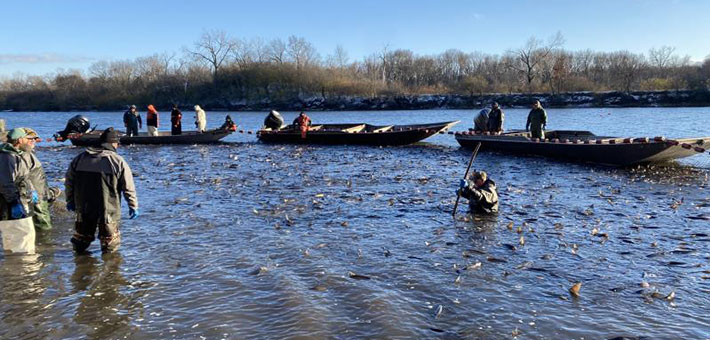IDNR concludes record-breaking invasive carp removal effort on Upper Illinois River
December 12, 2023
Contact:
Jayette Bolinski, jayette.bolinski@illinois.gov
Illinois Department of Natural Resources fisheries biologists, with support from contracted commercial fishers and biologists from the Illinois River Biological Station, wrapped up a 10-day intensive harvest operation in the Starved Rock pool of the Illinois River, resulting in the removal of an astonishing 750,000 pounds of silver carp between Nov. 27 and Dec. 6.
This is the largest single removal effort IDNR has undertaken and is believed to be a record for freshwater harvest within the United States.
“Clearly, this removal technique is highly effective, but it is also highly dependent on water levels and water temperature,” said Brian Schoenung, aquatic nuisance species program manager for IDNR. “This past week provided near perfect conditions, which facilitated the record-breaking haul of fish.”

IDNR uses funding support from the U.S. Environmental Protection Agency through the Great Lakes Restoration Initiative to contract with commercial fishers. These fishers, under supervision by IDNR staff, annually remove more than 1 million pounds of invasive carp from the Starved Rock, Marseilles, and Dresden Island pools of the Illinois River, especially targeting the Starved Rock and Marseilles pools.
These efforts help prevent invasive carp from becoming established in the Great Lakes by reducing the population pressure on the electric dispersal barrier system near Romeoville.
Reducing the numbers of adult fish in this area, where small fish have rarely been found, suppresses adult populations and upstream migration, reducing the risk of invasive carp nearing the electric dispersal barrier. During the past 13 years, such efforts have contributed to a nearly 95% reduction in the density of fish in these upstream areas, further protecting the Great Lakes.
“Our partnership with contracted commercial fishers has been highly effective at preventing the upstream advance of invasive carp,” said Justin Widloe, IDNR’s aquatic nuisance species program crew leader.
Contract commercial fishing is an annual event that begins in the spring following ice-out and continues to mid-summer when temperatures become too warm to harvest fish effectively. Efforts resume in September until freeze. IDNR biologists direct the contract commercial fishing effort to maximize removal in the upper Illinois River.
The seine operation used in on the Illinois River is an experimental effort to expand removal of silver carp. A seine is a fishing net that surrounds fish on the sides and underneath and brings them to the bank. It’s most effective in cool water when silver carp cannot jump out over the net.
Last year, crews utilized the seine to remove 350,000 pounds of invasive carp. As experience has grown, so has the effectiveness of this technique, culminating in the 750,000 pounds removed this month.

In total, such removal efforts contribute to approximately 1 million pounds of invasive carp removed from Illinois waterways annually. In 2023, the most recent catch will bolster total annual removal to 1.7 million pounds.
These efforts would not be possible without the support of Illinois-based invasive carp processors who provide trucks daily for removal and disposal of the fish. Both Sorce Freshwater in Peoria and Aquatic Protein in Beardstown provided trucking and removal support.
